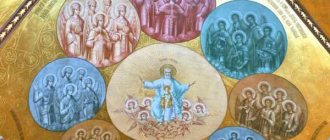Characteristic features of hagiography as a genre
From this follows the first distinctive sign of what living is.
The definition included some clarification: firstly, it was compiled about a real person . The author of the work had to adhere to the framework of a real biography, but pay attention precisely to those facts that would indicate the special holiness, chosenness and asceticism of the saint. Secondly, what is a life (definition): this is a story compiled for the glorification of a saint for the edification of all believers and non-believers, so that they are inspired by a positive example
An obligatory part of the narrative was messages about the miraculous power that God endowed with his most faithful servants. Thanks to God's mercy, they were able to heal, support the suffering, and perform the feat of humility and asceticism. This is how the authors painted the image of an ideal person, but, as a result, many biographical information and details of private life were omitted. And finally, another distinctive feature of the genre: style and language. There are many rhetorical exclamations, appeals, words and expressions with biblical symbolism.
Based on the above, what is living? The definition can be formulated as follows: it is an ancient genre of written literature (as opposed to oral folk art) on a religious theme, glorifying the deeds of Christian saints and martyrs.
Find information about Sergius of Radonezh in the library. Write down the names of the books.
Information from the library about Sergius of Radonezh for grade 4
The library has the following books that tell about the life of the saint: “Sergius of Radonezh”, “The Life of Sergius of Radonezh as presented for children”, “The Chosen One of the Holy Trinity”.
From these books I learned that the famous Saint Sergius of Radonezh was born around May 3, 1319.
But this is not accurate information, since none of Sergius’s contemporaries could provide such information, and perhaps did not want to.
Nobody knows for sure his place of birth either.
In the world he was called the youth Bartholomew.
It is known that among his three brothers, he was born second.
Unlike his brothers, Sergius of Radonezh was not good at studying, even reading was beyond his strength.
Only sincere faith in God helped Bartholomew overcome these terrible obstacles.
His disciple tells about the life of the saint.
He said that Sergius kept fasts until he was 12 years old and very often did not sleep in order to read prayers at night.
Such exploits embarrassed his mother and because of this, disputes arose in the family.
Soon their family became poor, and they moved to Radonezh.
The parents, knowing their son’s hobbies, asked him to become a monk only after their death.
Soon this happened.
In 1335, Sergius of Radonezh built a church, which the monk called the Holy Trinity.
And Bartholomew did a lot of significant things for the Motherland.
He even foresaw the fate of Prince Dmitry, who would win the battle with the Tatars.
Sergius of Radonezh saved people's lives with his prayers.
In 1392, Bartholomew died.
Western European Lives
From the first days of its existence, the Christian Church collects information about the life and activities of its devotees and communicates them for general edification. The Lives of the Saints constitute perhaps the most extensive section of Christian literature. Apart from the apocryphal Gospels and tales of the apostles, which contain a lot of detailed information about the first figures of Christianity, then the first in terms of the lives of saints were the tales of martyrs. Even Clement, Bishop of Rome, during the first persecution of Christianity, appointed seven notaries in various districts of Rome to daily record what happened to Christians in places of execution, as well as in prisons and courts. Another bishop of Rome, Fabian (—), entrusted this work to seven subdeacons. Biographer of St. Cypriana mentions that the names of martyrs, even of the simplest rank, have been written down by churches for honor and remembrance since ancient times. Despite the fact that the pagan government threatened the recorders with the death penalty, recordings continued throughout the persecution of Christianity.
Under Domitian and Diocletian, a significant part of the records perished in the fire, so when Eusebius (d.) undertook the compilation of a complete collection of legends about the ancient martyrs, he did not find sufficient material for that in the literature of martyrdoms, but had to do research in the archives of institutions that produced trial of the martyrs. Eusebius’s work on the martyrs has not survived to our time, but another of his works is known: “ The Book of the Palestinian Martyrs
"
From the first three centuries, several more “epistles” about martyrdom have reached us from one church to another. After Eusebius, tales of martyrdom were collected by St. Marufa, Bishop of Tagrit (c. 410), author of the History of the Persian Martyrs
.
Monk of the Benedictine monastery of St. Herman near Paris, Usuard (French: Usuard) (c. 876), compiled one of the oldest martyrologies in the West (“ Usuardi martyrologium
”, published in Louvain, and Antwerp).
A later, more complete collection and critical edition of the acts of the martyrs belongs to the Benedictine Ruinart: “ Acta Martyrum sincera et selecta
” (Paris,).
In addition to the martyrology of Uzuard, the following ancient Western martyrologies are known: Bede (735), Flora (French Florus de Lyon) (c. 850), Rabana Maurus (856), Vandelbert (870), Adon (875), Notkera (912)
The literature of the lives of saints of the second kind—venerables and others—is more extensive. The oldest collection of such tales is Dorotheus of Tire - the tale of the 70 apostles. Of the others, especially remarkable: “ The Lives of Honest Monks
» Patriarch of Alexandria Timothy;
then follow the collections of Palladius, Lausaic (“ Historia Lausaica, s. paradisus de vitis patrum
”, “
Historia christiana veterum Patrum
”, and also in “
Opera Maursii
”, Florence, vol. VIII).
In the West, the main writers of this kind during the patriotic period were Rufinus of Aquileia (“ Vitae patrum s. historiae eremiticae
");
John Cassian (" Collationes patrum in Scythia
");
Gregory of Tours, who wrote a number of hagiographic works (“ Gloria martyrum
”, “
Gloria confessorum
”, “
Vitae patrum
”), Gregory Dvoeslov (“”), etc.
Since the 9th century, a new feature has appeared in hagiographic literature - a tendentious (moralizing, partly political-social) direction, adorning the story of the saint with fictions of fantasy. Among such hagiographers, the first place is occupied by Simeon Metaphrastus, a dignitary of the Byzantine court, who lived, according to some sources, in the 9th century, according to others in the 10th or 12th century. His Lives of the Saints
"became the most common primary source for subsequent writers of this kind not only in the East, but also in the West.
Many lives of saints are found in collections of mixed content, such as prologues, synaxari, menaions, patericon. A prologue is a book containing the lives of saints, along with instructions regarding celebrations in their honor. The Greeks called these collections synaxarions. The oldest of them is the anonymous synaxarium in the manuscript of Bishop Porfiry Uspensky (1249), followed by the synaxarion of Emperor Basil, dating back to the 10th century. Other ancient prologues: Petrov - in the manuscript of Bishop Porfiry - contains the memory of saints for all days of the year, except 2-7 and 24-27 days of March; Kleromontansky (otherwise Sigmuntov), almost similar to Petrovsky, contains the memory of saints for the whole year. Our Russian prologues are adaptations of the synaxarion of Emperor Vasily with some additions. Menaions are collections of lengthy tales about saints and holidays, arranged by month. They are of service and Menaion-Cheti: in the first, for the biographies of saints, the designation of the names of the authors above the hymns is important. Handwritten menaions contain more information about saints than printed ones.
Who writes the lives of saints and how?
ABOUT THE HIGHLIGHT GENRE
The problem this article is devoted to was born relatively recently. Over the past decade, when hundreds of saints have been canonized, mostly those whose feats adorned the twentieth century, there has been an urgent need to write their lives. Here the problem arose: in what genre, in what manner should we talk about those people whose lives are still preserved in the memory of eyewitnesses and are sometimes even surrounded by contradictory memories?
So, the danger or problem when writing lives lies in “embellishment of the lives of saints,” “in exaggeration or understatement.” What is meant? It seems that, first of all, this refers to the introduction by the author of this or that life of his subjective assessments of the actions of the ascetic. Let me give an example from the book “New Martyrs of the St. Petersburg Diocese”: about the participants of the “Alexandro-Nevsky Brotherhood”, which operated in the city on the Neva for more than a decade, it is said that they were “romantics”
This is nothing more than the author's interpretation. The materials of the investigation into the said brotherhood indicate that the people who were members of it, despite the fact that they lived under the constant threat of arrest and physical harm, continued to serve the common cause. This is not romanticism, but courage. Although our last phrase is also evaluative. But, if it were part of the life, it would have to be designated as the answer to the question: “what is the edifying meaning of this saint’s feat.” This is how the lives that were included in the Chetya-Minea corpus were traditionally compiled. The author-compiler (first of all, we mean St. Dmitry of Rostov) remembered that the lives are part of Church Tradition. Therefore, they must be theologically verified, since they have a doctrinal meaning. Therefore, sometimes fascinating and interesting details were removed from the lives. The inclusion of any episode from the available biographies of the saint in his life was considered in the light of the question: what does this act or this word teach? Halftones, nuances, things that could confuse ordinary believing people, things that can be called “little things in life” that are not important for eternity were removed from the lives.
In general, in ancient times, reading the lives of saints was treated with almost the same reverence as reading the Holy Scriptures. There was even a special prayer that was said before reading the life: “Tell me the secret and unknown wisdom of Yours, for I trust in You, O God, that You may enlighten my mind and thought with the light of Your mind, not only in honor written, but also in creating, and not in It’s a sin for myself to read the teachings and lives of the saints, but for the renewal and enlightenment and salvation of my soul and for guiding me into eternal life.”
Every compiler of the lives of the saints of our time should remember this prayer - you cannot chase the amount of material, you need to weigh each piece of evidence before releasing it to the people. A sad example is a four-volume book dedicated to Elder Sampson (Sievers), published by his spiritual children more than a decade ago. Then, when the books in which materials about the elder were collected as completely as possible came out of print, we were very happy: finally, what had been “walking around in Samizdat” for many years had become “public.” But it soon became clear that this publication caused serious harm to the elder’s memory. Basic editorial work was not carried out. And therefore the book is full of contradictions. Elder Samson, as is typical for every elder, pronounced or wrote his teachings, addressing a specific person, taking into account the level of his consciousness and everyday circumstances. Therefore, on the same issue (the most striking example in the elder’s legacy is statements about raising children), he could give completely different advice. In the elder’s oral speech, there could also be errors in quotation and gaps in memory regarding some long-standing events. Before publishing all the surviving texts, they had to be verified and systematized. And now, “thanks to” the ill-conceived publication, some church people have developed a wary attitude towards the personality of Elder Sampson, confirmation of which they found in archival documents.
The author of these lines remembers a significant controversy surrounding the biography of the new martyrs of Optina - Hieromonk Vasily, monks Trophim and Ferapont. N.A. Pavlova, a Moscow journalist who settled almost from the very beginning of the revival of the monastery in a village near the Optina Monastery, collected a lot of materials from local residents, pilgrims, workers, and monks of the monastery about the brethren killed in 1993. Moreover, in these memoirs the collector sought to preserve the linguistic characteristics of the narrators (including village grandmothers with their folk dialect and former bohemians with their “party language”). The memoirs were accompanied by a rather lengthy author's text - Nina Alexandrovna's reflections on the destinies of the new generation, on the “new history” of the resurgent Optina, there were many author’s verbal portraits and the author’s assessment of the material being described and published. The monastery did not approve of such work. And they asked to rewrite everything “according to the canon.” N.A. Pavlova could not do this. Another person used her materials and, with the blessing of Optina Pustyn, published a series of books. It is no coincidence that they remained nameless, because they were truly compiled according to the canon, without unnecessary details, without emotional assessments, strictly and dryly. But when “Red Easter” by N.A. Pavlova was published, it turned out that the narrative of this particular genre was especially in demand by readers - in a short time the book, published in 20 thousand copies, was reprinted three times. In praise of N.A. Pavlova, let’s say that she edited her work for five years, listening to the wishes of spiritually authoritative people, and therefore there is almost no excessive author’s view in the final version. There are also some misleading details and speculations (the original version of “Red Easter” was twice as long as the published book). And there is a living, heartfelt story that really touched the souls of many people.
The example of N.A. Pavlova is worthy of imitation - she “did not look for her own,” but tried to use the truly bright talent of writing given to her for the glory of God, humbly agreeing with strict editorial corrections.
But among the compilers of lives there are also those who are clearly “looking for their own.” The saddest example is associated with the name of the old woman Pelagia of Ryazan. Ten years ago, in the newspaper “Eternal Life,” the “prophecies of Blessed Pelageya”, which confused many believers, appeared, accompanied by her life, and they were persistently distributed in copies among believers. And to this day this dissemination work has not subsided. The main motive of these prophecies is the sinfulness of the modern priesthood. I don’t want to retell the details of this clearly anti-church propaganda. Three years ago, with the blessing of Metropolitan Simon of Ryazan and Kasimov, the book “The Biography of Blessed Pelageya Zakharovskaya” was published. From her we learn that she was a true servant of God, and among her spiritual children there were many priests, those whom she herself inspired to this difficult choice of life path at that time. And none of the admirers of the blessed one testify that the main thing in her feat was the exposure of the vices of the priesthood.
Even if the blessed one said something on this topic, people should not be embarrassed. When resolving such issues, the work of not just a literary, but a theological editor is necessary, although again the author’s position is of great importance. So, for example, the author of the life of St. Seraphim of Vyritsky - V.P. Filimonov did not include in the story about the Venerable Elder the story of the bitter fate of his son. And the compilers of the life of St. right John of Odessa tells in detail what sorrows the saint endured from his children. In the life of St. right John of Kronstadt says nothing about the complexities of his relationship with the Petrograd priesthood. And in life sschmch. Seraphim (Chichagov) tells about the opposition of the Synod in the canonization of St. Seraphim of Sarov. In various “life excerpts” of St. Nicholas of Japan tells different stories about his mission. Some speak of her unclouded success, while others, based on the saint’s authentic diaries, draw attention to the difficulties of his feat in the “land of the rising sun.”
In author's books about recently departed ascetics, those who knew them personally find “authorial arbitrariness” even more so. Thus, the book about schema-nun Antonia (Kaveshnikova), which captivated many, gave rise to a claim among those who knew her personally (as opposed to the author-compiler of the Life) that the image of the mother was conveyed implausibly. The book about Elder Macarius, “Given by God,” aroused suspicion among people who do not like the intensification of mysticism about the lack of spiritual sobriety in its author. Schimon's book caused real confusion. Nikolai (Groyan) about the ever-remembered elder Nikolai Zalitsky. First of all, by the insistent assertion about the secret schema-monastery and bishopric of the priest. Examples can be multiplied.
There is probably only one way out for now. If the author allows himself to make some kind of individual selection of facts when writing the life of an ascetic (when there are many sources), he is obliged to put his name before the text. Thus, he will be responsible for the interpretation. And we have such hagiographic authors (following the example of Nilus, Poselyanin, Shmelev and Zaitsev), these are A. Ilyinskaya, A. Strizhev, N. Konyaev, V. Voskoboynikov, V. Krupin. In their lives there is only their own, unique writing style. It must be said that it is not always possible to agree with him; sometimes such lives resemble works of art with the main character and other characters. And their essence can be defined with the words: “the image of a saint created by writer N.”
Recently, one person “from the writing fraternity” told me an instructive story about how he compiled the life of an ascetic elder revered in Ukraine. In the monastery where the ascetic labored, he was provided with a mass of already collected archival materials and eyewitness memories, and he enthusiastically began studying them and compiling a life. Over the summer, he wrote an entire book, in which, in his opinion, he only retold the materials provided to him. In the fall, after the father abbot and the brethren of the monastery had familiarized themselves with the manuscript, an unexpected verdict came from them: everything needed to be rewritten, because the life was written in a condemning tone. “The elder was loving and forgiving, and you denounce his persecutors. This is not his spirit." Thank God, the compiler of the above-mentioned life found the courage to sit down to work again and began to remove from it his “author’s style,” which included the exaltation of the elder by exposing his enemies. But not every writer has the patience and humility to “step on the throat of his own song.” This is how evidence of the ill-conceived, uncalibrated position of their authors appears in the lives of already glorified saints.
So, in the “hagiography genre” there is currently a great diversity, in addition to the “varieties of hagiographies” we have already named. There are lives written for different children's ages (from kindergarten to high school students); publication of handwritten editions of the same life with abundant commentary; scientific studies in which the life of the saint is included in the “context of time”; ideological program lives in which the ascetic is declared the banner of some social movement, most often of a nationalist nature (this is more related to Catholic saints).
Let's return to where we started this article. Thus, it turns out that not every life can be added to Church Tradition. There are lives that can be called “the fruit of individual creativity.” We have historical examples of reinterpretation of the feat of our saints by L. Tolstoy, D. Merezhkovsky, L. Andreev and D. Andreev, N. Roerich and occultists of various persuasions. And now the lives of Orthodox saints may appear in the series “Great Soothsayers” or “Great Healers,” in which paganism is mixed with Christianity, although the mixture is not directly stated. Therefore, whenever you get your hands on another book with materials from the biographies of modern ascetics, you need to read it with reasoning, asking for the opinions of spiritually authoritative people.
In pre-revolutionary times, our theological schools discussed an issue that is again on the agenda - the need to introduce a new subject into the curriculum called “Hagiology” or “the doctrine of Orthodox holiness.” Our time urgently requires a theological substantiation of the Orthodox teaching on holiness. And not only at the level of teaching in special religious educational institutions, but also at the general church level. If this work is completed by learned theologians, then it will be easier for the editors who are preparing this or that life of the saint for publication.
Let us also recall the decision of the Holy Synod of December 26, 2002 “On the streamlining of practices related to the canonization of saints in the dioceses of the Russian Orthodox Church,” which states “that when preparing materials for the canonization of saints, the following should be taken into account: 1. Materials for the canonization of an ascetic must be carefully prepared and considered by the Diocesan Commission for the Canonization of Saints, which was decided by the Council of Bishops in 1992 (see Act on Canonization.., paragraph 11: “Establish in all dioceses of the Russian Orthodox Church commissions for the canonization of saints to collect and study materials for canonization of ascetics of faith and piety, especially martyrs and confessors of the 20th century, within each diocese”). 2. The publication of unverified materials related to the life, exploits and suffering of clergy and laity of the Russian Orthodox Church is unacceptable. Such evidence should be verified locally with the blessing of the Ruling Bishop. The Ruling Bishop can give a blessing for the publication of such materials only after personally familiarizing himself with their content.”
Let us also recall that in the decision of the Council of Bishops in 2000. there is a definition: “Together with the glorification by name of ascetics whose feat has already been studied. The Council of Bishops glorified all the Russian new martyrs and confessors of the 20th century who suffered for Christ, so far unknown to people, but known to God.”
Such glorification of the entire host of the Russian new martyrs and confessors of the 20th century, named and unnamed, who suffered for Christ for Christ, did not leave all the saints of this period outside the church veneration before God.
ABOUT THE LANGUAGE OF LIVES
Reading hagiographic literature has always been a favorite in Rus'. People are accustomed to trusting Lives as an indisputable source, and only in the last century the question of the authorship of Lives arose. We thought that the information given in the life and how it is presented largely depends on the author-compiler. Surely, those who read the entire Menaion noticed that among the many lives, sometimes for some reason very similar to each other, there are real pearls of hagiographic literature that stand out among the general mass. Usually these are lives written by direct disciples of saints or, in extreme cases, disciples of disciples (such, for example, are the lives of St. Alexander of Svir and St. Sergius of Radonezh).
In order to see how different stories about the same saint told by different authors can differ, it is sometimes enough to compare different editions of the same text. Particularly characteristic in this sense are the lives compiled for the great Council of the Hundred Heads in 1547 - they were all written based on a certain church-political concept. It was important to approve the succession from Byzantium and the idea of “Moscow - the Third Rome”. It is this era - the beginning of the 16th century - that gives us a curious phenomenon: the image of the saint was considered by the author depending on what ideal of asceticism he professed - Josephite or non-covetous. If the life was written by a defender of the idea of a symphony between the state and monasteries, the idea of educational and state-forming relations of the monastery to the world, then the saint boasted of these very virtues. If the life was written by a non-possessor, then he first of all affirmed in the image of a saint his love in solitude, escape from the world, the path of personal intimate asceticism. Often the compilers of hagiographies allowed themselves lengthy authorial digressions and teachings of a general plan.
When writing a life, the literary tastes of its compiler also matter a lot; in other words, the language that was spoken and written at that time is important. Our time has given rise to a completely special type of life - a dry archival story, on the basis of which the reader himself can create the image of an ascetic. Or - this is especially interesting - a type of hagiography has emerged, compiled from the memories of various people, while preserving the unique conversational style of each of them (stories are most often written down in oral retelling). The most interesting, in my opinion, are the lives written by Bishop. Varnava (Belyaev) and nun Maria (Skobtsova) - they combine high artistic style with liveliness of presentation and appeal to the modern reader and his problems. It is written about the ancient saints as if they were our contemporaries - because the temptations and exploits that befell them are shown as eternal.
Several versions of the lives of the Optina elders exist. In my opinion, the most valuable and interesting remains what the disciples collected during the life of the ascetics. There are several options for the lives of the blessed. Matrons. Oh St. right John of Kronstadt, thank God, a lot of literature is coming out now. They even began to compile a scientific chronicle of his life. All this is very joyful. This means that we grow, that we get the opportunity to recognize saints not only in the established “face of saints,” but on the way to it. We can see the most important thing - the real path to holiness, and in the case of the saints of the last times - in circumstances that are very close and understandable to us.
The diversity of hagiographic literature forces us to be legible, collected, not to skim over the usual cliched phrases, but to read into unique, dissimilar texts. This is very good - our time does not allow us to make our faith a habit, a form in which it is convenient to live. Our time constantly demands to keep content in a changing world. And at the same time, we seem to be returning to the situation of the “golden age” of Christian writing, when various hagiographic genres existed and descendants had the opportunity to read the original “Acts of Martyrdom,” and not just retellings of them by one or another author.
In this article we did not touch upon another “hagiographic genre” - stories, novels and short stories that modern writers write based on materials from the lives of saints. This is a special topic and quite painful. In my opinion, we have very few successful experiences in this genre. You need to be S. Nilus or E. Poselyanin to be able to talk about the saint in such a way that bad taste does not come through, or even worse, your own passion does not obscure the bright images of our saints. And this often happens when they begin to put some direct speech into the mouths of saints.
But it’s also good that lives are now being published for different ages, for different levels of people’s perception. There are, for example, numerous children's versions of the lives of St. Seraphim of Sarov or St. Sergius of Radonezh. There are traditional lives in the style of “weaving words,” and there are scientific texts, when the image of a saint is inscribed in the context of his era, so that everyone can choose what is closer and more necessary to them. Let us repeat once again, if only there were no “gags” in these publications, unnecessary author’s digressions and bad obsession.
HOW TO READ THE LIVES OF THE SAINTS
It would seem a strange question, but not an idle one. After all, modern people tend to see “myths and legends” in everything. And he can perceive Life in this way. Our ancestors defined the purpose of reading hagiographic literature as follows: “The lives of saints instill the fear of God in the soul, the abandonment of the evil, the acceptance of the good: for those who see their lives, they come to a sense of their deeds, they think about the abandonment of the evil; For this is the light of the lives of the saints and the enlightenment of our souls.” These are the words of one of the ancient writers of Lives (after all, they were copied by hand and it was very difficult work).
In one old handwritten collection we find a prayer appeal - a request for a correct understanding of life: “Tell me the secret and unknown wisdom of Yours, for I trust in You, O God, that You may enlighten my mind and thought with the light of Your mind, not only to honor the writing, but also to create Let me not read the teachings and lives of the saints as a sin, but for renewal and enlightenment and for the salvation of my soul and for escort to eternal life.”
It is a custom among church people, having risen from sleep (or, in extreme cases, the night before), among the usual prayer rules, to address prayer appeals to the saint whose memory is indicated in the church calendar. The author of these lines has to admit that now it is rarely possible to do this (you justify yourself by lack of time, but that’s probably not the point). And there were times when it was possible to even read the entire life of the holy day - and now these times are remembered as the most blissful. And, perhaps, this reading has remained the main baggage of Christian wisdom to this day, and not all kinds of scientific books, of which many have been read. In the lives of saints one can find reasons for resolving various difficulties that arise in life. And, if samples of the actions and words of saints are stored in memory, then with the help of God, they sometimes come to mind at the right moment and keep us from recklessness, and sometimes simply from stupidity.
Even the Lord in his earthly life often used examples from the lives of the Old Testament righteous. So to resolve the questions of the Pharisees: is it possible for hungry people to grind ears of corn and eat on the Sabbath? Our Savior pointed to the example of David, who ate the showbread - and the Pharisees had to remain silent.
And in our time, when they tell us: “Your Church is graceless. You have no continuity.” You can answer: “Look how many saints we have. The 20th century gave them more than the entire history of Christianity in Rus'. This means that those who denounced “historical Christianity” were wrong. The accusers almost all disappeared abroad, and those whom they denounced testified to the faith with the blood of martyrdom.
We need to read their lives primarily for the “renewal and enlightenment of the soul.”
And from my scanty experience I can say that this reading sometimes actually produces a prayerful effect: you read the life and involuntarily become imbued with the spirit of this saint. The same thing happens when you have to retell lives at lectures, in broadcasts or in articles - you also involuntarily become imbued with reverence for the saint. I remember how many years ago I came to Optina with a question to Elder Elijah: “They ask me to give lectures about the elders, but I’m afraid. I'm so bad." Father replied: “Always think that you are bad, but your deed is good. People need to talk about the saints, and even if the one who speaks or writes about the saints is himself unworthy, the words of the saints and their lives do not fade from this.” I had to read these lectures more than once - and it turned out to be a source of consolation, because I always remembered: “You are bad, but your work is good.”
HOW DO CATHOLICS UNDERSTAND HOLINESS?
Much has been written about the difference between the Orthodox and Catholic ideals of holiness. But, as we know, even the most dogmatically complex problems are most easily understood with the help of specific examples. And here is the brightest example of our time, our contemporary Mother Teresa, revered during her lifetime in the West as a saint. We know a lot about her activities. Almost all of her exploits were widely covered in various media. Which in itself is also precisely a manifestation of Western “witness” or missionary work. At the same time, an Orthodox nun, Elder Gabriela, lived with Mother Teresa. She also worked with lepers in India. She also traveled all over the world, helping people with their physical ailments (she was a doctor), she was undoubtedly a missionary. But they didn’t write about her in the newspapers, they didn’t interview her, they didn’t film her in a group of politicians or senior hierarchs - all this is alien to Orthodox asceticism. We learned about Mother Gabriel only after her death, when her students collected her sayings and published a book. Now it has been translated from Greek and published in Russian. The teachings of Mother Gabrielia, in fact, cannot even be called teachings - these are conversations, simple conversations with loved ones. When talking with them, she simply shares her memories of what she saw and experienced during her travels. And, if you look at the thematic index at the end of the book, you will be surprised to notice that Mother does not speak at all about the desire for holiness, or about self-examination.
In order to understand how the Catholic ideal differs from the Orthodox ideal, it is enough to open Mother Teresa’s last book, “No Greater Love...”. All of it is permeated with a conscious desire for holiness. The book has a chapter “On Holiness” and there is an example of a characteristic Catholic prayer: “He is the God who loves us, the One who created us. Turning to Him, we can ask Him: “My Father, help me! I want to be a saint, I want to be kind, I want to love! Holiness is not a luxury reserved for some elite; it is by no means prepared for a select few. We are all called to it, you, and I, and everyone else.” I said that this is a characteristic Catholic prayer, because the petition for holiness is found in the lives of ancient and modern Catholic saints; according to the testimony of Western people I personally know, it is also common for ordinary Catholics. Mother Teresa in the same book states: “To say: “I want to be a saint” means to take the path of God, the path of salvation.”
An Orthodox ascetic would answer this: “To say: “I want to become a saint” means to take the path of delusion, self-delusion and narcissism.” So, while performing even great deeds of mercy, one can live constantly inwardly pleasing oneself with one’s holiness.
But we, Orthodox neophytes, often without realizing it ourselves, take the same path. In a “heart-to-heart” conversation with one woman, I heard: “I constantly think about how God intended me to be. What should I be? And every day I note what I did against that holy image.” “We shouldn’t evaluate ourselves on a scale of holiness,” I told her. And she was very surprised: “Isn’t this what the Fathers teach us?” - “No, they teach us to look not forward at our holiness, but always to look at our real sinfulness.”
From the lives of Orthodox saints, we know that none of them thought that he was holy, did not even imagine in himself any rudiments of holiness. And from century to century the teaching was repeated: “It is not a great thing to see an angel; it is a great thing to see your sins, like the sand of the sea.”
List of hagiographic works of Russian literature
Peruvian Russian authors own about 156 texts related to the genre of hagiography. The first of them are associated with the names of princes Boris and Gleb, treacherously killed by their own brother. They also became the first Russian Christian martyrs-passion-bearers, canonized by the Orthodox Church and considered intercessors of the state. Next, the lives of Prince Vladimir, Alexander Nevsky, Dmitry Donskoy and many other prominent representatives of the Russian land were created. A special place in this series is occupied by the biography of Archpriest Avvakum, the rebellious leader of the Old Believers, written by himself during his stay in the Pustozersky prison (17th century). In fact, this is the first autobiography, the birth of a new literary genre.
Life as a genre of ancient Russian literature
Russian literature is almost a thousand years old.
This is one of the most ancient literatures in Europe. It is older than French, English, and German literature. Its beginning dates back to the second half of the 10th century. Of this great millennium, more than 700 years belong to the period that is commonly called “ancient Russian literature.” Old Russian literature, up to the 17th century, does not know or almost does not know conventional characters. The names of the characters are historical: Boris and Gleb, Theodosius of Pechersky, Alexander Nevsky, Dmitry Donskoy, Sergius of Radonezh, Stefan of Perm...
None of the works of Ancient Rus' - translated or original - stands alone. They all complement each other in the picture of the world they create. Each story is a complete whole, and at the same time it is connected with others. This is only one chapter of the history of the world.
One of these paintings is the Life, intended to become a biography of clergy and secular persons canonized by the Christian Church. The Life was based on the biography of a hero, most often a historical person known to the author personally or from the stories of his contemporaries. The purpose of the Life was to glorify the hero, to make him a model for followers and admirers. “The Life is not a biography, but an edifying panegyric within the framework of a biography, just as the image of a saint in the Life is not a portrait, but an icon.” Lively faces and instructive types, a biographical frame and an edifying panegyric in it, a portrait and an icon - this unusual combination reflects the very essence of the hagiographic artistic method of depiction. It is necessary to emphasize the importance of the hagiographic genre, since it was in it that throughout the Middle Ages people were told about people. The Hero of the Life, regardless of his wealth or poverty, social status and learning, was perceived by any reader as his own kind. The reader could see himself in this hero, could envy him, take his example, be inspired by his exploits. The fate of a person and, moreover, attempts to look into his inner world, poeticization of spiritual achievement could not help but attract hearts and minds to this type of literature. This was the only story about human destiny in the Middle Ages.
If we look at the structure of the Life, we will notice a whole literary structure, some details reminiscent of an architectural building. It usually begins with a lengthy, solemn preface, expressing the author’s unworthiness, his many sins, invoking the help of God and the saints, and a view of the significance of the saint in the matter of salvation.
The introductory part is also characterized by numerous quotations and parallels from the sacred books. Then the activity of the saint is narrated, destined from infancy, sometimes even before birth, to become God's chosen vessel of high talents; this activity is accompanied by miracles during life, and is sealed by miracles after the death of the saint. The life ends with a word of praise to the saint, usually expressing gratitude to the Lord God for sending down to the world a new lamp that illuminated the path of life for sinful people. All these parts are combined into something solemn, liturgical: the Life was intended to be read in church at the all-night vigil on the eve of the saint’s memorial day.
The Life is addressed, in fact, not to the listener or reader, but to the one praying. It more than teaches: teaching, it tunes, strives to turn a soulful moment into a prayerful inclination. It describes an individual personality, personal life, but this chance is valued not in itself, not as one of the diverse manifestations of human nature, but only as the embodiment of an eternal ideal.
The canonical scheme of the Life thus served as the best plan for depicting the ideal hero and the idealized world in which he performed his righteous deeds. But from the very first steps in the development of the hagiographic genre, the canon was violated under the influence of life facts. These violations usually hardly affected the main character, but they even more significantly affected other characters. And the more talented the hagiographer was, the more significant was the deviation of his work from the church template.
Page from the great Chetya Menaion
From the beginning of writing, the collections of Lives (“menaion”, “prologue”, “patericon”) were transferred to Ancient Russia through the South Slavs and translated directly from the Greek language, and the original Lives of the first Russian saints - Boris and Gleb, Theodosius of Pechersk ( XI century) and others. Russian authors of Lives carry the ideas of independence of the political and church life of the young Kyiv state; sometimes they deviate in many ways from the canons of Greek hagiography.
Sometimes the Lives are based on only individual dramatic episodes from the lives of saints (the story of the murder of Boris and Gleb), internal monologues and emotional dialogues are introduced, in some cases the type of biography changes: sometimes it is a simple story, rich in historical and everyday observations (the life of Leonty of Rostov, XII century), then a military-patriotic story (Life of Alexander Nevsky, Dovmont of Pskov, XII-XIV centuries), then a poetic fairy tale (Life of Peter and Fevronia, XV-XVI centuries).
The second South Slavic influence (late 14th - early 15th centuries) promotes the development in Russian hagiography of a florid rhetorical style - “weaving words”, as a result of which the emotionality and psychologism of the narrative increases. A group of prominent hagiographers appears: Metropolitan Cyprian, who reworks the Life of Metropolitan Peter, Epiphanius the Wise (Lives of Sergius of Radonezh, Stephen of Perm), Serbian Pachomius Logothetes (Life of Cyril of Belozersky, etc.). In the era of strengthening the centralized Russian state (16th century), hagiography began to serve the ideological objectives of the government. Carrying out the policy of Ivan the Terrible in the field of spiritual life, Metropolitan Macarius greatly expands the host of Russian saints and directs the compilation of their Lives, which are combined in the Great Four Menaions (12 huge volumes), including almost the entire heritage of translated and original hagiography circulating in Rus', newly revised and rhetorically decorated. In the 17th century, collections of the Four Menaions of German Tulupov (1627-1632), Ivan Milyutin (1646-1654) and Demetrius of Rostov (ed. 1689-1705) were compiled. In the XV-XVII centuries, a particularly large number of new Lives were created, dedicated to the monks of the Russian North and reflecting the colonization role of the monasteries, their struggle for land with the peasantry. Features of real life are increasingly being introduced into the hagiographic style; Lives are gradually moving closer to everyday stories (The Life of Juliania Lazarevskaya). In the second half of the 17th - early 18th centuries, new Lives were created dedicated to representatives of the religious movement - the schism. Their heroes are opponents of the state Church, cursed by it and persecuted by the tsarist authorities (The Lives of Ivan Neronov, Morozova, Kirill Vygoretsky, etc.). This direction of hagiography tends to depict folk life and is distinguished by its “vernacular” style. The genre of the biography of a saint develops into the genre of instructive and polemical autobiography of the “apostles” of the schism (The Lives of Habakkuk, Epiphany).
Based on the volume of biographical material presented, as a rule, two types of life are distinguished: biographical (bios) and martyrdom (martirios). Bios gives a description of the life of a Christian ascetic from birth to death, martirios tells only about the martyrdom of the saint. The latter form is more ancient, associated with the persecution of the first Christians. This type of Lives is based on the “protocols” of interrogations of Christians, so they are, as it were, documented. A full biography is not taken; only the torment of the saint is told.
Another group of Lives told about Christians who voluntarily subjected themselves to various kinds of tests: rich young men secretly left home and led a half-starved life of beggars, subjected to humiliation and ridicule; the ascetics, leaving the cities, went into the desert and lived there in complete solitude (hermits). A special type of Christian asceticism was pillarism, in which the saint lived for many years on top of a stone tower - a pillar, and in monasteries ascetics could seclude themselves in a cell, which they did not leave for an hour until death.
Among the Byzantine Lives, the most widespread are translations of the lives of Alexy, the man of God, Andrew the Fool, Barbara, St. George the Victorious, Dmitry of Thessaloniki, Catherine, John Chrysostom, Nicholas of Myra, Paraskeva Pyatnitsa, etc.
Lives of Russian saints were created throughout all centuries of the existence of ancient Russian literature - from the 11th to the 17th centuries. These lives can also be systematized according to the type of heroes: princely lives, lives of church hierarchs, builders of monasteries, ascetics for the glory of the church and martyrs for the faith, lives of holy fools. In addition, the Lives can be grouped according to a geographical principle - according to the place of life and exploits of the saint and the place of origin of the Lives (Kyiv, Novgorod and North Russian, Pskov, Rostov, Moscow, etc.).
In some cases, we learn about the authorship of certain lives from the text of the works themselves, based on indirect data. Nestor the Chronicler (XI-XII), Epiphanius the Wise (XIV-XV), Pachomius Logothet (XV) - these are the most famous authors of Russian lives.
Grouping the lives by the nature of the heroes, we note: - Lives of ascetics for the glory of the Church and the founders of monasteries (Alexander Svirsky, Varlaam Khutynsky, Abraham of Rostov, Sergius of Radonezh, Stefan of Perm, etc.);
— Lives of the hierarchs of the Russian Church - metropolitans (Alexy, Jonah, Cyprian, Peter, Philip);
— Lives of holy fools (St. Basil, John of Ustyug, Mikhail Klopsky, etc.).
Of the princely Lives, the most famous are the Lives of Alexander Nevsky, Boris and Gleb, Prince Vladimir, Dmitry Donskoy and others.
There are few Lives of Women in Russian hagiography: Anna Kashinskaya, Euphrosyne of Polotsk, Euphrosyne of Suzdal, Juliania Vyazemskaya, Juliania Osoryina, Princess Olga. The influence of legendary fairy-tale motifs on hagiographic literature was also not spared. Local legends sometimes influence the authors so strongly that the works they create can be classified as Lives only because their heroes are recognized by the Church as saints and the term “Life” may appear in their title, whereas in terms of their literary nature these are clearly plot-narrative works. These are “The Tale of Peter and Fevronia of Murom” by Ermolai-Erasmus, “The Tale of Peter, Tsarevich of Ordynsky”, “The Tale of Mercury of Smolensk”. In the 17th century, Lives appeared in the Russian North, completely based on local legends about miracles occurring from the remains of people whose life path was not connected with exploits for the glory of the Church, but was unusual - they were sufferers in life. Artemy Verkolsky - a boy who died from a thunderstorm while working in the field, John and Loggin Yarensky - either Pomors, or monks who died at sea and were found by the inhabitants of Yarenga on the ice, Varlaam Keretsky - a priest of the village of Keret, who killed his wife, who himself committed himself for this ordeal and forgiven by God.
Only the Old Russian Life gives us the opportunity to observe personal life in Ancient Rus', albeit raised to an ideal, processed into a type from which a correct hagiographer tried to shake off all the petty concrete accidents of personal existence. Often this is a kind of local chronicle of a remote corner, which has not left a trace either in the general chronicle or even in any written record. Such records of miracles were sometimes kept on behalf of the abbot and the brethren by specially appointed persons, with interviews of those healed and testimonies, with the circumstances of the case written down, being more likely business documents, books of formal protocols, than literary works. Despite this, they sometimes vividly reflect the life of the local world, which flowed to the grave or tomb of the saint with its needs and illnesses, family troubles and social troubles.
The Lives, in turn, shaped the views of ancient Russian readers on the ideal of holiness, on the possibility of salvation, cultivated philological culture (in its best examples), and created ideal forms of expressing the feat of the saint.
Anastasia Yakovleva
Cover
Literature
- Life // Literary encyclopedia of terms and concepts / Ed. A. N. Nikolukina. - Institute of Scientific Information for Social Sciences of the Russian Academy of Sciences: Intelvac, 2001. - Stb. 267—280—1596 p. — ISBN 5-93264-026-Х.
- Barsov N.V.
Lives of the Saints // Encyclopedic Dictionary of Brockhaus and Efron: in 86 volumes (82 volumes and 4 additional). - St. Petersburg, 1890-1907. - Zubov V.P.
Epiphanius the Wise and Pachomius the Serb (on the issue of the editions of “The Life of Sergius of Radonezh”) // Proceedings of the Department of Old Russian Literature of the Institute of Russian Literature. M.; L., 1953. T. 9. P. 145-158. - Dmitriev L. A.
Hagiographic stories of the Russian North as literary monuments of the 13th—17th centuries: Evolution of the genre of legendary-biographical tales / Rep. ed. A. M. Panchenko; Institute of Russian Literature (Pushkin House) USSR Academy of Sciences. — L.: Science. Leningr. department, 1973. - 304 p. — 6850 copies. - Klyuchevsky V. O.
Old Russian lives of saints as a historical source. M., 2003. - Likhachev D.S.
Man in the literature of ancient Russia. M., 1970. - Ranovich A. B.
How the lives of the saints were created. - M.: Gospolitizdat, 1961. - 72 p. — (Popular science library on atheism). - Serebryansky N.
Old Russian princely lives. (Review of editions and texts). M., 1915. - Troitsky S.V.
// Orthodox Theological Encyclopedia. - St. Petersburg: Petrograd Publishing House. Supplement to the spiritual magazine “Wanderer”, 1904. - T. 5. - Stb. 582
What is life in literature?
Over time, life, as church literature, gradually began to degenerate into an independent literary genre. Of course, at first, these works were the property of the Church and were written by church ministers.
But there were some reasons that, even at the dawn of the emergence of this genre, brought it closer to high literature:
- A detailed narrative connected by a single plot and certain canons of writing a work.
- High style of storytelling, careful study of true history and its reflection in the work.
- The author's professionalism in creating not just a historical description, but a genuine work.
- Storing handwritten biographies, republishing them in the future and putting them in the form of books.
All these signs became the starting point for the fact that the lives quite soon became independent artistic creations
They paid great attention not only to the exploits of the saint, but also to the description of his righteous life, worthy of reflection in literature and history.
Thus, the genre of hagiography has become a historical and biographical epic, reflecting not only the life of a particular person, but also the time in which he lived. The geographical and even historical details of the era of the life of the hero himself were colorfully described. Therefore, many works have become important documents for the research and study of the past.
The meaning of the word life
Examples of the use of the word life in literature.
The fact is that the combination of adventurism with acute problems, dialogism, confession, life and preaching is not at all something completely new and has never happened before.
Grandfather prophesied the lives of Saint Labre, covered in lice, and Saint Mary Alakok, who licked the feces of the sick with her tongue.
Or Abba Alexy himself, or even Leonty-Stanyata, Stanka simply, a young novice, a Novgorod resident, who had joined the Trinity monastery, whom Sergius, having experienced and realized that the solitary life of the cinnamon was not for him, sent as a companion to Alexy, who was going to Constantinople, fortunately Stanyat, unknown how, almost self-educated, learned to understand Greek.
The most important events for Rus' are told under the years: 941, which includes Igor’s first campaign against the Greeks, described according to the Amartol chronograph and partly according to the Greek life of Vasily the New, under 944 - the year of the second campaign, in the description of which the participation of a folk legend is obvious, and under 945 , where the text of Igor’s treaty with the Greeks is placed and then it is also told, according to the folk Kiev legend, about Igor’s last Drevlyan campaign for tribute, about the death of the prince and about the first acts of Olga’s revenge.
Arefa always envied the clean monastic life, and the sexton herself told him more than once that it was time to take up God’s work and forget about worldly things.
He, however, heard that life is not easy for the communists, well, to hell with them, you can read from the little red book until the Ashanti go back, and then make your own legs.
Fedosk the heresiarch and others like him clearly began to fight the entire church, destroy fasts, impute repentance and mortification to some kind of fable, turn womanlessness and self-willed squalor into laughter, and change other obstinate and narrow paths of cruel Christian life into smooth and spacious paths.
And the joy of upholstered furniture, and the joy of a cozy room - after a thousand years of unsettled, tattered, unyielding living.
In the first months, when the high mortality rate and primitive bivouac life did not allow the guards to keep an accurate count of prisoners, frozen corpses were often left in the huts for several days, receiving bread rations and gruel coupons for them in the brigades.
Deciding, on the strength of this reflection, to relieve Birkin from his shift, Sinyavsky stood up and almost burst into tears, remembering his home life, sweet and carefree.
He stood in the middle and, without further conversation, wheezed in a deep bass voice: “A prosperous and peaceful life, health, salvation and good haste in everything, grant victory and victory to the enemy, Lord!”
And when we were returning to the monastery through the five-virgate field, Holy Father James began to piously tell us the life of St. Gregory, when suddenly there was a sound like a raging stream, and a vile demon jumped over the high wall around the meadow and rushed towards us faster than the wind.
Living with Zeldner, who demanded from Vasily Afanasyevich either dried cherries or some other gifts from Vasilyevka’s savings, life, which lasted until he switched to government money in 1822, was bitter and offensive.
From these two, as from a showcase example, one could judge the lives and deeds of the remaining knights of the cheeky and great-martyr Black Hundred brotherhood.
From the life of Evdokia the Great Martyr You can’t take the Dunaevs’ porch right off the bat: it’s slanted, sideways, the steps and the top flooring, so whether you like it or not, you’ll start pushing your hands against the wall.
Source: Maxim Moshkov library
Signs of life as a literary genre
The first sign of the existence of hagiography as literature is the fact that the story was told about a person who actually lived. Accurate adherence to biographical and historical facts was mandatory.
But with an emphasis on his good life, for which the Lord gave him miraculous power. That is, the story itself was supposed to serve as an edification to believers, and even more so to non-believers, so that they could see before them a worthy example of serving God, and therefore people. This is the second sign of the genre’s independence—the ideological background of the work.
And one more thing is the style of the work and its language. The entire life was written in sublime tones in order to elevate the hero in the eyes of the reader. Hence a lot of high, laudatory, enthusiastic words and expressions. And of course, the entire narrative was replete with church and biblical vocabulary, references to the Old and New Testaments, and church canons.
So, we can summarize what living is. This is a genre of ancient literature that describes the earthly path of a person who is now considered a saint. And this is not folk art, but the conscious creation of a highly artistic work on religious themes with the biographies of Christian saints.
Lives of the Saints
Hagiographies have long been the most popular in ancient Rus'. They were written according to strict canons and, in fact, revealed the meaning of human life. One of the most striking examples of the genre is “The Life of St. Sergius of Radonezh,” set forth by Epiphanius the Wise. Here there is everything that should be in literary texts of this type: the hero comes from a pious family of righteous people, obedient to the will of the Lord. God's providence, faith and prayers support the hero from childhood. He meekly endures trials and trusts only in God's mercy
Having realized the importance of faith, the hero spends his conscious life in spiritual labors, not caring about the material side of existence. The basis of his existence is fasting, prayer, taming the flesh, fighting the unclean, asceticism
The lives of Russian saints emphasized that their characters were not afraid of death, gradually prepared for it and accepted their departure with joy, as this allowed their souls to meet God and the angels. The work ended, as it began, with glorification and praise of the Lord, Christ and the Holy Spirit, as well as the righteous man himself - the venerable one.
Genres of religious literature
Ancient Rus' acquired its written language along with spiritual books that were brought from Byzantium by Greek priests. And the first Slavic alphabet, as you know, was developed by the Solun brothers, Cyril and Methodius. Therefore, it was church texts that became the source of knowledge from which our ancestors comprehended book wisdom. The genres of ancient religious literature included psalms, lives, prayers and sermons, church legends, teachings and stories. Some of them, for example the story, were subsequently transformed into the genres of secular works. Others remained strictly within church boundaries. Let's figure out what life is. The definition of the concept is as follows: these are works dedicated to describing the lives and deeds of saints. We are not talking only about the apostles who continued the preaching work of Christ after his death. The heroes of hagiographic texts were martyrs who became famous for their highly moral behavior and suffered for their faith.
Tasks and goals of life
The primary task of the life was not just a description of the life of the saint. After all, a person began to be revered as a saint for certain services to God and people. This means that his path in life is necessarily the path of a hero. Therefore, in his biography, a special place was given to his exploits. Moreover, they were described exclusively in a praising manner, so that the reader would be inspired by his deeds and, of course, would strive to get closer to godly deeds.
Of course, the story itself was built on a certain principle. After all, what does the word life mean in its original sense? Still, it comes from the word life. This means that the narrative began with the birth of the saint, and often with the life of his parents and ancestors, and ended with his repose and continuation of heavenly life, his veneration by the Church, and the creation of posthumous miracles. And during the description of his earthly path, his exploits, miracles performed, and splendor were described in all colors.
The lives of people who did not do anything heroic in life, but who became saints because of the miracles they performed after death, could also be described.











